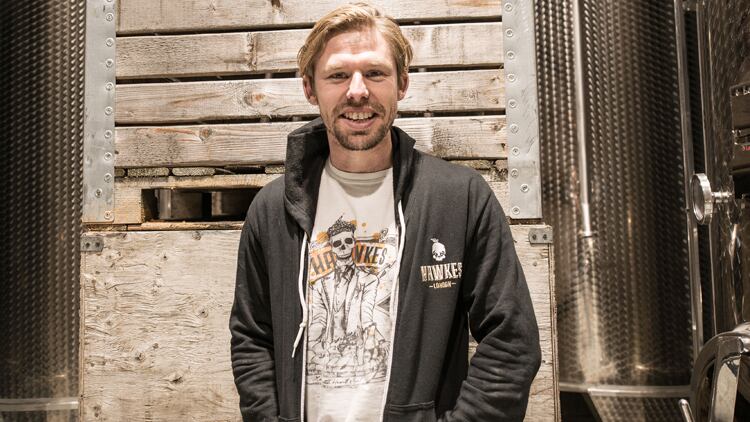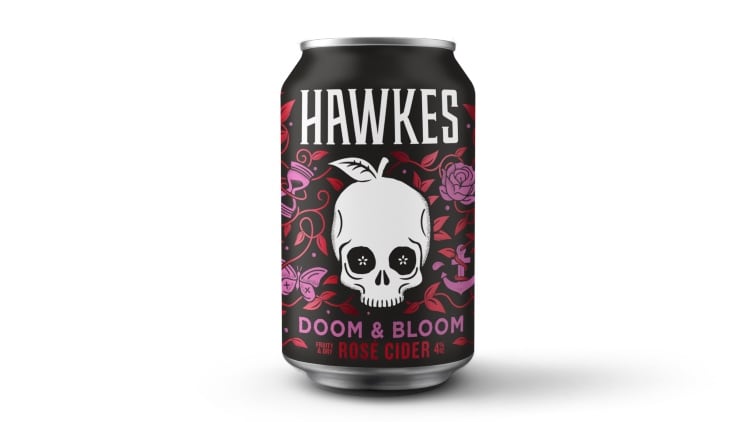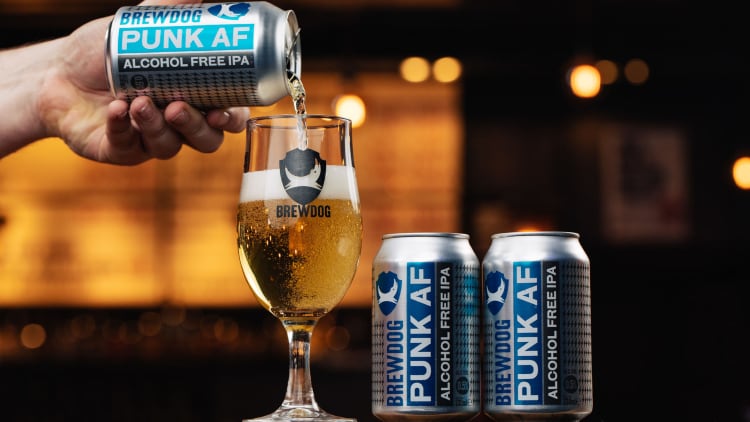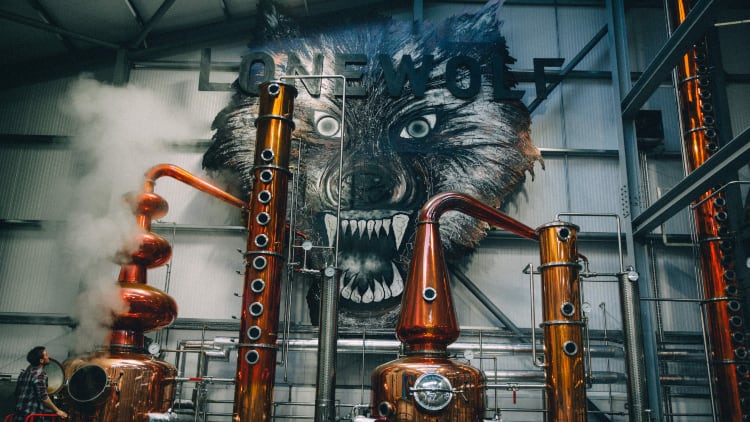One of the first things Simon Wright admits as we stand in a stainless-steel orchard beneath a railway arch on the Bermondsey Beer Mile is his cider’s new home is far from the drink’s natural habitat.
However, founded in 2013 and on a mission to introduce drinkers to the untapped potential of craft cider and save the category from dominance by ‘big brands’, Hawkes urban cider is far from a natural successor to the category’s West Country stalwarts.
Having worked for industry giants AB InBev and Greene King, Wright followed what he describes as a “well-trodden path” in giving up his job and surrendering a salary for two-and-a-half years to set up his own business.
“A ‘hawker’ was a street seller, that’s where the name comes from: someone who hustles and builds something from the ground upwards,” Wright explains. “That’s our ethos and our mindset as a business. We’ve gone from me at home, a one-man band, to being available all over the country and in the US.”
Despite the shiny new equipment and an admittedly unnatural backdrop of London’s Shard, Wright explains having social purpose at Hawkes’ heart is paramount.
“We started making cider from fruit donated by locals because it follows our ethos: ‘you’re not going to use it, it’s waste product, let’s turn it into cider if you’re not going to do anything else with it’. Now we’re the UK’s biggest urban cidery.”
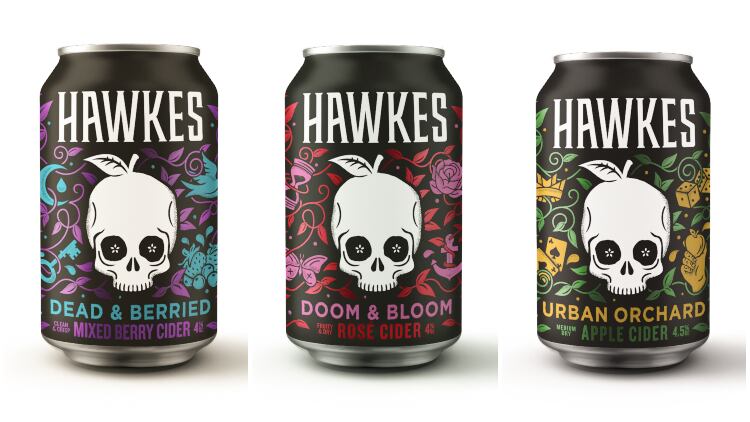
On-trade presence
“We’re really lucky – we work with most of the bigger retailers in some shape or form,” Wright explains. “Mitchells and Butlers has Urban Orchard in three or four hundred of their accounts and we have cider in some Greene King pubs. Our focus in trying to bring craft cider to a bigger audience is to get it listed in keg in some of these really big customers.
“Would we like to have a base up north, in the Midlands and other places? 100% we would. Outside of the South-West – where they’re really into their cider – pubs are just starting to think about how congested the beer market is and that maybe having a range of ciders and being able to talk about cider as a point of difference to beer is now a thing.”
The cider maker’s first steps into the world of apples has been accelerated by BrewDog acquiring the business in April 2018. The craft brewer and operator of more than 80 sites worldwide saw Hawkes as a “kindred spirit” and made its move at a time when Wright had independently been trying to get Hawkes’ ciders listed in BrewDog’s sites. The apple hasn’t fallen far from the tree.
“As a combined force, there’s going to be quite a lot of opportunity for us and them to push on. We’re really excited,” he explained. “Their marketing and products are on point. If we can take a leaf out of their book for cider then we’re on to a big thing.
“One of the reasons I looked to work with them was the presence they had – not just internationally – but mainly in America. We will be looking to launch Hawkes in the US in August and that’s a big project and a big focus for us now.”
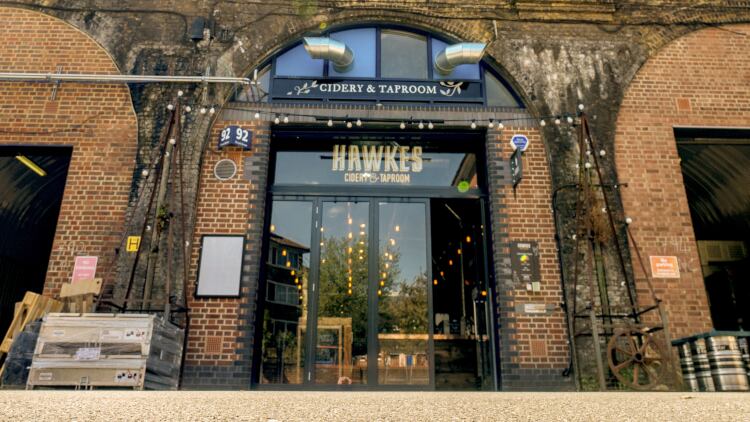
Fruit cider
Coverage of fruit cider on The Morning Advertiser is regularly met by complaints that no such sub-category exists. However, Hawkes cider’s Simon Wright explains it plays a crucial role as an entry point for younger consumers.
“Fruit cider, to me, is still cider because it should still have an apple base to it,” he clarifies. “Then it’s got flavours or real fruit blended into it.
“As a growing cider maker you’ve got to realise there’s a market for it and cater accordingly. For us, if fruit cider is the entry into Hawkes for a mid-20-something who used to love Kopparberg but now prefers our fruit ciders like Dead and Berried or Doom and Bloom and then starts to discover we do single varieties and stuff like that, why would you cut that audience off?
“Fruit cider is about 25% of the overall market now, right? So you’re missing a huge chunk if you don’t cater for it.”
Park bench mentality
BrewDog’s American presence not only offers Hawkes a platform to broaden its distribution but take inspiration from Stateside cider and give the UK category a much-needed facelift according to Wright.
“The thing cider doesn’t have in the US is any associated baggage,” he explains. “It doesn’t have what I call the ‘park bench mentality’. The amount of times we’ve had people come in here with a friend who’s really up for cider and say, ‘I’m not touching cider, the last time I had cider was a bottle of White Lightning on a park bench in my teens’.
“If you go into a bar over there, bars are charging more for craft cider than they are for craft beer – in the UK it’s the opposite, cider is still seen as a relatively cheap product.”
This goes back to cider’s 400-year history in the UK and long-standing tradition around the category, which Wright doesn’t see as exclusively detrimental but believes can prevent younger people engaging with the category.
“I’m not saying tradition is negative itself but over the years the cider industry has lost its ability to talk and educate people about what real cider is,” he says.
“Craft cider is still in its infancy – companies like CGA don’t even categorise it yet. There are lots of reasons for that, things I’ve pointed to in the past like the different taxation – that’s obviously a fundamental reason why there aren’t so many growing craft cider makers. They are out there, but they all get to a certain limit and then are unable to push on.”
According to Wright, while traditional cider brands distance themselves from modern competitors often dismissed as ‘not real cider’, the latter offer younger drinkers an important entry point to the category. For Wright, the fact that the likes of Kopparberg and Rekorderlig are drunk en masse across university students and younger drinkers puts the category in an “amazing place”. “It might not be great cider but they’re drinking cider nonetheless, that’s what cider needs to wake up to – you’ve got this whole group of people who are drinking Rekorderlig and Kopparberg. As taste and awareness mature, it’s our obligation to try to keep them in cider.”
However, Wright acknowledges modern ‘big cider’ brands that Hawkes ultimately aims to “save” the category from, are better than their traditional counterparts at drawing younger consumers into cider as a result of their branding and marketing – “It’s not just the taste, they do cool stuff – experiential things,” he explains.
“When you go to a cider ‘thing’, it’s all about apple bobbing – none of it’s on point. Look at Brothers Cider – the Brothers bus was an institution at Glastonbury. Every festival was an awesome experience getting in front of that many people.
“That’s what being on the Beer Mile is about – this is about getting cider to an audience that come here because they want to learn about craft products – whether its beer or gin, though don’t get me wrong we would love to do more experiential stuff.”
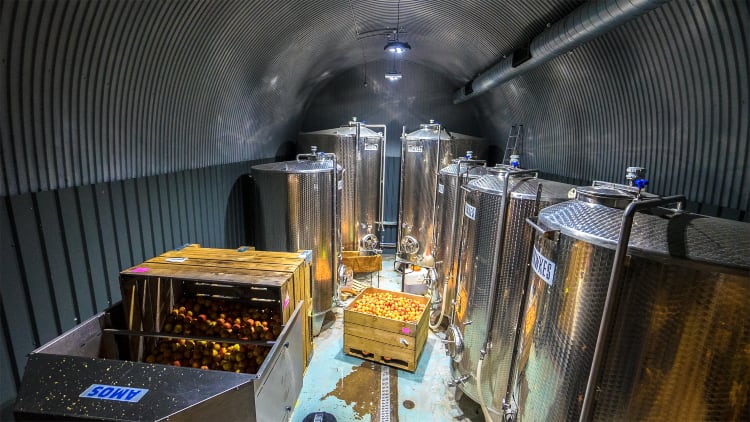
‘Big cider’ does important job
“Anyone that markets their product well is doing a good job for the category,” Wright adds. “Whether or not the product follows the ethos we would follow is debatable, but the fact they’re getting the name ‘cider’ out to people regardless of the liquid is really important.
“I would slag off a product but would never slag off the brand. I’d happily tell you ‘that’s a poor cider’ but in terms of the way big brands market cider and get it into people’s hands, it’s brilliant.”
This is one point where Hawkes appear to differ from BrewDog. While its website details ambitions to be the “saviours of cider”, it doesn’t go in on big brands to the same degree as BrewDog’s James Watt and Martin Dickie – who recently accused big brewing brands of the “bastardisation and commoditisation” of beer.
“If people come into the cider category, try something and then realise they want something with taste, flavour, heart and soul – something they can really align themselves with – that’s fine.
“If you apply the same thing to fashion – when you’re 18 or 19 you’re very lucky if the things you’re wearing out are top of the range, it might be Primark. But then you move on, you’ve got to start somewhere. In the long run, we’ll benefit.
“For me, you’ve got lots of not-so-educated cider drinkers drinking Strongbow, Kopparberg and other brands, who will naturally grow up and fall into us. Then from the other end you’ve got people who are really educated, knowledgeable and really understand drink, love it and passionately talk about it and want to know what’s in the product. If we can appeal to them as well then we’re getting it from both sides.
“That’s the ambition anyway. In terms of the growth of the business over the past five or six years, we’re starting to prove that can work. There aren’t that many ciders like us and I think it’d be a good thing if there were more – ones that are pushing the boundaries, changing the status quo and growing at a rate that means they can do cool stuff.”
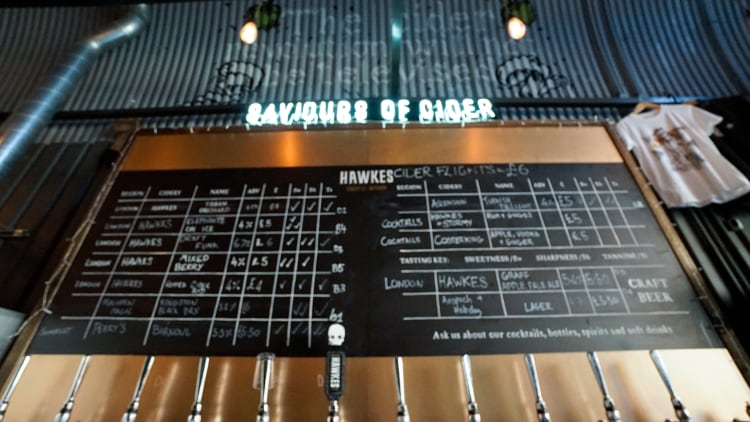
Cracking the craft beer market
Wright explains while the product Hawkes is making is closer to wine in terms of base product and process – the branding and marketing mirrors craft beer.
“We’re talking about approaching the cider market like craft brewers approach the beer market – the craft beer drinking audience is definitely one to crack,” according to Wright.
“One of the things brewers do extremely well, not only to push flavours and profile of beer but also self-market, is collaborate.”
One-way Wright has opened Hawkes up to the craft beer category is by taking cider to strange new places, for example in experimenting with ‘graff ’.
“I nicked this idea completely from the US,” he says. “A graff is a 50:50 co-fermented beer and cider. Just as they’ve finished making the wort and they’re about to pitch the yeast to turn it into beer, you combine 50% wort and 50% apple juice and ferment them both together. The final product is almost like an apple beer sour.
“Again, the reason we did it is because the product is quite cool and different.”
However, product innovation, partnerships with BrewDog and giving UK cider a facelift aside, Wright acknowledges education needs to be at the core of its operation if Hawkes is to save cider.
“We know we have to educate people. I guess that’s the whole premise about ‘Saviours of Cider’ it’s about saving people from fake and bland cider.
“If no one understands what cider’s made from and how you get to that end product then they’re never going to appreciate it.
“That’s the future for cider, people falling in love with it and really understanding it.
“When we get to the point of having saved it, I’ll probably be dead by that point. There’s so much to go at. We sell four times more cider than the US – the market is here and the volume is huge, but the knowledge and understanding of cider is tiny.
“We’re probably five to 10 years away from getting the kind of momentum that craft beer has at the moment.”

